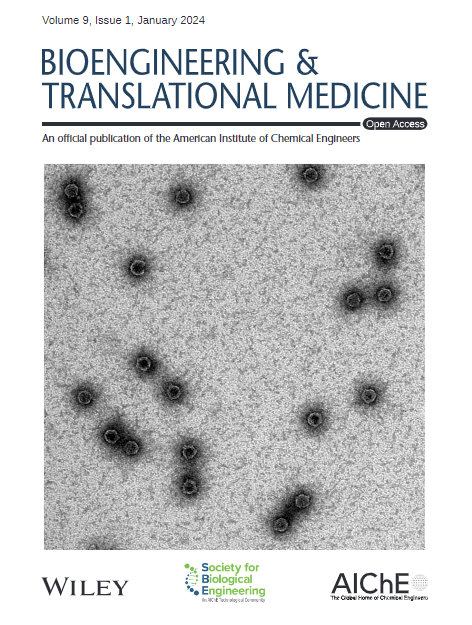Extracellular vesicles from glucocorticoids‐preconditioned synovial mesenchymal stem cells exert antiarthritic effects by downregulating the mRNA m6A modification of NLRP3 in macrophages through miR‐212‐5p
IF 6.1
2区 医学
Q1 ENGINEERING, BIOMEDICAL
引用次数: 0
Abstract
Osteoarthritis (OA) is a prevalent chronic degenerative joint disease with no known treatment for reversing its progression. However, recent studies have shown promising results for nano‐sized extracellular vesicles derived from preconditioned synovial mesenchymal stem cells (SMSCs) in treating various diseases, including OA. Glucocorticoids (GCs) possess potent anti‐inflammatory properties, but their long‐term use is limited due to potential adverse reactions. Building on previous research, this study aimed to investigate the therapeutic potential of extracellular vesicles secreted from GCs‐pretreated SMSCs (GCs‐EVs) in exerting antiarthritic effects. The results demonstrated that GCs‐EVs effectively inhibited cartilage degeneration and osteophyte formation in the OA mouse model by suppressing the release of inflammatory cytokines from synovial macrophages. This effect was attributed to the high expression of miR‐212‐5p in GCs‐EVs, which specifically inhibited the expression of methyltransferase‐like 3 (Mettl3). Consequently, the mRNA N6‐methyladenosine (m糖皮质激素预处理的滑膜间充质干细胞细胞外囊泡通过miR - 212 - 5p下调巨噬细胞NLRP3 mRNA的m6A修饰,从而发挥抗关节炎作用
骨关节炎(OA)是一种常见的慢性退行性关节疾病,没有已知的治疗方法可以逆转其进展。然而,最近的研究显示,来自预处理滑膜间充质干细胞(SMSCs)的纳米细胞外囊泡在治疗包括OA在内的各种疾病方面有希望的结果。糖皮质激素(GCs)具有有效的抗炎特性,但由于潜在的不良反应,其长期使用受到限制。在先前研究的基础上,本研究旨在探讨GCs预处理的SMSCs分泌的细胞外囊泡(GCs - ev)在发挥抗关节炎作用方面的治疗潜力。结果表明,GCs‐ev通过抑制滑膜巨噬细胞炎症因子的释放,有效地抑制OA小鼠模型的软骨退变和骨赘形成。这种效应归因于miR - 212 - 5p在GCs - ev中的高表达,特异性地抑制了甲基转移酶样3 (Mettl3)的表达。因此,巨噬细胞中nod样受体pyrin结构域3炎症小体(NLRP3)的mRNA N6‐甲基腺苷(m6A)水平降低,导致NLRP3炎症小体活性降低,抗关节炎作用增强。此外,在共培养系统中,GCs - ev通过抑制巨噬细胞分泌炎症因子来增强软骨细胞的增殖和迁移,同时抑制软骨细胞凋亡。
本文章由计算机程序翻译,如有差异,请以英文原文为准。
求助全文
约1分钟内获得全文
求助全文
来源期刊

Bioengineering & Translational Medicine
Pharmacology, Toxicology and Pharmaceutics-Pharmaceutical Science
CiteScore
8.40
自引率
4.10%
发文量
150
审稿时长
12 weeks
期刊介绍:
Bioengineering & Translational Medicine, an official, peer-reviewed online open-access journal of the American Institute of Chemical Engineers (AIChE) and the Society for Biological Engineering (SBE), focuses on how chemical and biological engineering approaches drive innovative technologies and solutions that impact clinical practice and commercial healthcare products.
 求助内容:
求助内容: 应助结果提醒方式:
应助结果提醒方式:


